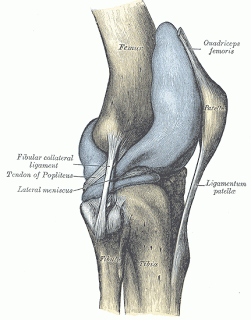
This week’s question is a follow-up question that came in after the post we did on yoga and knee replacements (see Knee Replacements and Yoga) and Shari’s answer to another reader about pain after a total knee replacement (see Friday Q&A: Pain After a Total Knee Replacement). It seems that pain isn’t uncommon after a knee replacement, but in this case, the pain is coming several years after the replacement:
Q: My partial knee replacement was April 2007. I started back to Yoga this past summer-one day a week, but I found child pose with the knees wide uncomfortable, but I did do it for a few weeks this fall. I now have some pain in my knee and I’m hoping that I haven’t loosed the cement in the joint. Any help would be appreciated.
A: Thanks for writing in about this new pain in your knee. As always, I am not able to diagnose or prescribe a yoga program for you without first doing a more detailed history and physical exam in person, but I can share some thoughts that come to mind from the situation you find yourself in.
One of the challenging things to discern for new yoga students, or those returning after a long break from doing yoga is: How to gauge if “uncomfortable” is a potentially harmful warning sign from your body? This is tricky, because it may simply be that you are getting some intense sensation feedback from the body as you stretch and strengthen parts of your body that have been neglected for a long time. With the knees in particular, learning to recognize the difference between the healthy stretch sensation of the muscles and connective tissue lengthening versus the compression of the tissues and bones that often happens deep folds of the knee joints is an important skill to cultivate. The compression sensations can sometimes indicate pinching of tissues that could lead to inflammation, injury or bruising that may not resolve quickly or could lead to more chronic pain. It is sometimes hard to skip these poses—like Child’s pose—in a public class since they are so common unless you have an alternative offered by your teacher. I often suggest that folks with knee pain flip onto their backs and draw the knees to the chest, essentially an upside down Child’s pose. Then almost all the pressure is off the knee joint and usually no pain is felt. The other thing to try is to vary the distance of the knee spread in regular Child’s pose until you find a distance that does feel uncomfortable.
It is also important to recognize that undergoing a knee replacement does not equal having the same healthy knee anatomy and movement you had before the surgery and the underlying knee problem that lead to your surgery. One of my students who had knee surgery to clean out a lot of arthritis damage to his cartilage found that his range of motion was less after the surgery than before, but he was now pain free. His challenge became how to gradually see if he could improve the range of motion without leading to recurrent pain.And another student of mine who had one knee replaced, but also had a second bad knee, found that although the new knee operated normally, the second knee become more painful secondary to the new way he was walking with essentially two very different knees. And sadly, having a successful repair does not guarantee that future dysfunction and pain will not arise.
In this case, it is also important to recognize the effect of the passage of time on both the surgerized knee and your other knee. A substantial amount of time has passed from 2007 until this summer of 2013. And with that the knees can undergo gradual changes in the architecture and function of the joint, such that the repaired knee can undergo undesirable changes, and unrelated changes could also have taken place. It could be that something has loosened in the replaced knee parts, but it could just a likely be some other structure, tendon, muscle or other structure, that could be the source of this new pain. This needs investigating!
Until you have an exam and get a diagnosis from your orthopedic MD, avoid the positions that create immediate or delayed pain in the affected knee. Poses like Child’s pose include Hero pose, Thunderbolt pose (as well as poses that have just one leg in the deep flexion fold at the knee joint), front knee in Pigeon pose variations, the front knee in deep drop knee lunges, and any Lotus preps or full and half Lotus pose. Even some simple seated poses like Sukasana (Seated Crossed Legs) can be worth avoiding until you know what you have going on. Once you get a clear picture of what is happening, I’d suggest setting up a private session with an experienced yoga teacher or yoga therapist to design a home practice that can address your unique situation.
—Baxter
Follow Yoga for Healthy Aging on Facebook ° To order Yoga for Healthy Aging: A Guide to Lifelong Well-Being, go to Amazon, Shambhala, Indie Bound or your local bookstore.


Leave A Comment